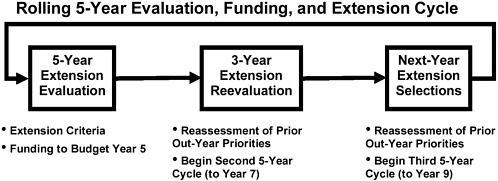Executive Summary
The Earth science missions of the National Aeronautics and Space Administration (NASA) are routinely planned and funded on the basis of a nominal mission lifetime. If the mission is still functioning at the end of this nominal lifetime, there are often strong scientific and operational reasons for extending it. But the decision to do so and commitment of the needed resources must be weighed against use of the same resources for developing new observational capabilities and research missions.
NASA has recently begun using the Senior Review process, developed for the space sciences,1 to make decisions on extensions for Earth science missions. Previously, these decisions had been made ad hoc. This report by the National Research Council’s Committee on Extending the Effective Lifetimes of Earth Observing Research Missions reviews the current process and provides recommendations for adapting this process to the specific needs of NASA’s Earth science missions.
Finding. NASA’s mission-extension paradigm for accomplishing research missions—which is based on planning and funding nominal operational lifetimes, with a separate decision process for extending operations when this nominal lifetime is exceeded—is fundamentally sound.
-
Implementation of the mission-extension paradigm warrants a structured and uniformly applied process that balances the desirability of extending a mission against the feasibility of doing so.
-
An effective mission-extension process must carefully reconcile the long lead times required for budget planning against the benefits of deciding as late as possible which missions will be extended.
-
Earth science missions have unique considerations, such as future operational utility and interagency partnerships, that distinguish them from space science missions; these considerations should be explicitly included in a mission-extension decision-making process.
Recommendation. NASA should continue to formally plan and fund research missions on the basis of the mission-extension paradigm, but it should (1) ensure that the unique requirements of Earth science missions are satisfied and (2) investigate alternative approaches to mission life-cycle funding in particular cases.
Finding. The Senior Review, currently used as the basis for all NASA decisions on space and Earth science mission extensions, is a thorough and well-run process, but it does not adequately satisfy the unique considerations of Earth science missions.
Recommendation. NASA should retain the Senior Review process as the foundation for decisions on Earth science mission extensions, but should modify the process to accommodate Earth science’s unique considerations.
-
The evaluation process should be expanded to complement the NASA-only evaluation with a parallel evaluation through which non-NASA partners can provide their assessment of the need for mission extension—the final NASA decision would be made on the basis of input from both paths.
-
The overall process should be built around a 5-year rolling approach to evaluations (see Figure ES.1), involving incremental evaluations beginning several years in advance of the final decision, so as to increase community visibility and facilitate partner commitments, with a biennial status briefing that includes all potential partners.

FIGURE ES.1 The rolling-wave planning approach to the mission-extension decision process, as recommended by the committee.


